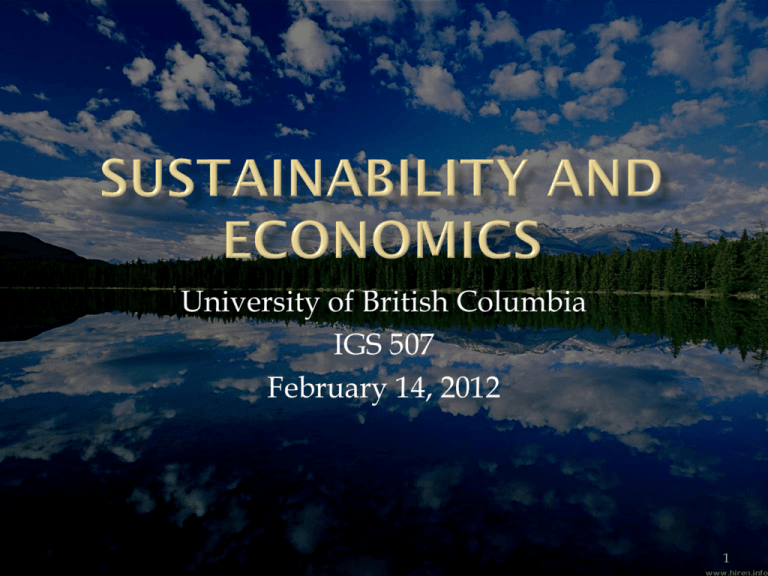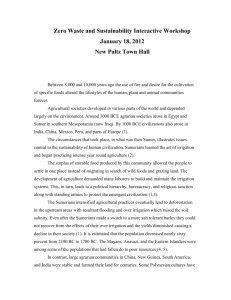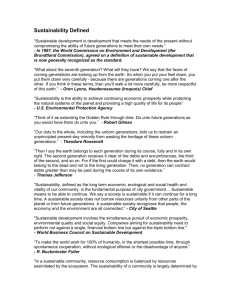Sustainability and Economics - University of British Columbia
advertisement

University of British Columbia IGS 507 February 14, 2012 1 Pipeline to ship Bitumen from near Edmonton to Kitimat. 2 Benefits (according to Enbridge): British Columbia: 3000 construction jobs, 560 ongoing. $1.2 billion tax revenue over 30 years. $830 local goods and services purchased. Alberta: 380 long term jobs. $350 million tax revenue over 30 years. $232 local goods and services purchased. 3 Benefits (according to Enbridge). First Nations Communities 10% Equity stake (~$280 million income). Training, employment. Community trust fund, $100 million. Canada $270 billion GDP growth. $81 billion tax revenue (all levels of government). 1,150 permanent jobs. 4 Costs (Enbridge does not mention any): British Columbia: Habitat loss, etc. along route of pipeline. Community changes. Risks of spills, etc. during construction and operation. Alberta: As for British Columbia. Risks/costs of spills, etc. likely lower. 5 Costs (Enbridge does not mention any): First Nations: Substantial change to way of life. Canada: Higher oil prices, negative impacts on users of fossil fuels in Canada. Globe: Loss of ‘value’ people place on protecting pristine habitats in British Columbia. 6 Questions: Do the benefits exceed the costs? No formal cost-benefit analysis has been done. Are all those affected going to be better off? Some efforts here – community trust, FN equity stake. Are incentives in place for risk management? Claims of ‘state of the art’ and such. Some talk of liability cap for Enbridge. Is proposal consistent with Sustainability? 7 Sustainable development is development that meets the needs of the present without compromising the ability of future generations to meet their own needs. Report of the World Commission on Environment and Development: Our Common Future (1987) 8 Definitions (Oxford online): Sustainable – able to be maintained at a certain rate or level, Development – the process of developing or being developed, Need – a thing that is wanted or required. Using the definitions: Changes we make to the world today are sustainable if they don’t compromise the ability of future generations to achieve what they want or require. 9 From ‘Our Common Future’, sustainable development not about keeping the world from changing. The core imperative is that current development not compromise ability of future generations to meet their needs. What must we provide future generations with? 10 What will future generations need (want and require)? Requirements: Wants: What will be essential for future generations? What will future generations want? What are we obligated to sustain? 11 12 Ability of society to provide physiological needs? Does our responsibility stop here? Protecting physical resources? Ability of society to provide higher needs? Does much of this depend on how future societies choose to organize themselves? Protecting knowledge (Plato, Confucius, Mill, …)? 13 What to sustain depends on substitutability. Substitutability: The ability of one thing to take the place of another. Weak vs strong sustainability. Weak – we don’t have to do much to achieve it Strong – we have to do a lot to achieve it. Hinges on substitutability 14 Asset: Thing that provides a stream of services over time. House, car, computer, education, watershed, … Portfolio: A collection of assets. Investors shift around assets in a portfolio to achieve investment goals. Wealth maximization, risk minimization, … Often a balance of somewhat conflicting goals. 15 Capital That which is invested to generate a stream of services over time. Types of Capital: Financial capital Physical (built) capital Human (knowledge and skills) capital Social (relationships and trust) capital Natural (ecosystems and resources) capital 16 Individually and collectively we manage a portfolio of capital assets. John’s portfolio Financial capital: (not much) Physical capital: (house and vehicle) Human capital: (lots – way overeducated) Social capital: (introverted academic, not much) Natural capital: (own little, share quite a bit) 17 We can ‘spend’ from one type of capital and ‘invest’ in another. Capital can be improved or degraded. Need to maintain my house and vehicle. Invested heavily in my human capital. Had I spent less time in school and more working, probably would have more financial, physical, and maybe social capital. 18 Development The process of changing societies portfolio of assets. For society, financial capital is not really capital. Serves to facilitate movements between other capital stocks. Development Generation of knowledge (human capital) that enabled conversion (degradation) of natural (and social?) capital into physical capital. 19 Weak sustainability. Assumption: Capital assets are largely interchangeable in ability to provide for human needs and wants. Implication: Don’t have to worry about loss of natural capital (or any type of capital) provided ability of total capital stock to provide services is maintained. 20 Strong sustainability. Assumption: It is impossible to substitute for (many of) the services provided by natural capital. Implication: At a minimum, total stock of natural capital must be maintained. In very strong case, total stock of many individual types of natural capital must be maintained. 21 Is this proposal consistent with sustainability? Construction degrades some natural capital. Operation puts some natural capital at risk. Use facilitates more rapid consumption of fossil fuel from Alberta. To satisfy weak sustainability, must sufficiently increase other types of capital. To satisfy strong sustainability, must invest in offsetting natural capital. 22 Compensating capital (Weak Sustainability) Building physical infrastructure, Providing training, esp. opportunities for first nations, Funding a community trust fund. Generating significant wealth for shareholders. If substitutability high, pipeline may satisfy conditions for weak sustainability. 23 Compensating natural capital (Strong Sus.) Rehabilitate areas that would not otherwise be rehabilitated to compensate for lost habitat. Create artificial wetlands and spawning channels to compensate for damaged aquatic habitats. Proposal has at best a nod to ensuring no net change in natural capital. Does not appear to satisfy constraints of strong sustainability. 24 What about the oil? Project facilitates burning of fossil fuel from Alberta. Questions: Would stopping project lead to less climate change? Can using a finite resource like oil be consistent with sustainability? 25 Fossil fuels are non-renewable. Stored sunshine / sequestered carbon. Natural production insignificant on human time scale. Most uses of fossil fuels damage environment Burning it contributes to climate change Activities facilitated (e.g. urban sprawl) cause further environmental damage. 26 Can environmental impacts be controlled? Carbon capture and storage (CCS)? Learn to live with higher sea levels, warmer climate, etc. Would impacts occur anyways? Will we still want sprawling cities and single family homes if we have electric cars charged with solar power? 27 Suppose net environmental impact for using fossil fuels is zero. Should we use them? Pretend that CCS can work. In physical terms, fossil fuel use is sustainable if use equals natural regeneration. Oil produced by unique geologic events, may not be producing any right now. IF goal to ‘sustain’ oil stocks (treat like a fish stock), THEN should not use any. 28 Sustaining stock of oil on earth implies no use. Not saving for future to use, as nobody can use it as any use deprives those who come later. BUT Sustainability about ensuring future people can satisfy wants and requirements. Can we use oil now in such a way that future generations are better able to meet their needs? 29 Oil in ground part of natural capital. But is not providing any (known) services in situ. Can we use oil to generate capital that benefits future generations? Build physical capital (roads, universities, solar panels, …) Build human capital (education, research, …) Build social capital 30 Conclusion Using fossil fuels may be consistent with sustainability IF it is used (invested) so that future generations are able to meet their needs without the use of fossil fuels. Implication Need to measure impacts of our choices How is the composition of our portfolio changing? How are the components performing? 31 To satisfy strong sustainability Measure size of critical natural capital stocks Ensure that stocks are not reduced Same for other capital stocks To satisfy weak sustainability Measure contribution of services from capital stocks to satisfying human needs. Ensure that ability of total capital stock to satisfy human needs is not decreasing. 32 Measuring ecosystem services. VS Measuring the value of ecosystem services. 33 Ecosystem services Water filtration by a wetland, Soil stabilization by vegetation on a slope, Biodiversity provided by a habitat, Resilience provided by a diverse habitat, Ascetic pleasure of a viewscape, … 34 How to value an ecosystem service? What is the value of a spirit bear? Priceless? Does a spirit bear have intrinsic value? Value in its own existence. Does a spirit bear have ‘agency’? Are animals responsible for their actions? Are invasive weeds guilty of a crime? 35 Non-humans not seen to have agency. Cannot be held responsible for decisions. Sustainability is about human choices. Human impacts on environment. Decisions made by humans about things humans value. Fundamentally anthropocentric. One may believe that spirit bears have right to exist. Person’s belief, not bear’s, and person acts on belief. 36 Economics study how people make decisions in the face of scarcity. What tradeoffs are people willing to make. How much of one thing are people willing to give up to get more of another thing. Economists observe behavior and impute values from people’s own choices. People reveal their preferences. 37 Stated preference methods Sometimes no actions reveal preferences – no tradeoffs involving environmental resources. Carefully ask people to state their preferences. People may have difficulty with tradeoffs People may refuse to state a preference (lexicographic). People may form preferences after interacting with others. People may have trouble stating acceptable tradeoffs, but in real situation, they make them. 38 The impact of time People are impatient Impacts can occur at different times. Need to compare impact next year and in 100 years. Prefer $100 today over $100 next year, and $100 next year over $100 in two years. Discounting Scale costs and benefits such that those further away in time are worth less in the present. Bank account in reverse. 39 Justifying discounting Future will be richer, can afford greater cost. People are impatient. No guarantee here tomorrow. Alternative investments do exist. Social discount rate Individuals finite, society not Society more ‘concerned’ for long term than individuals. 40 Example values (www.ecosystemvaluation.org) (CV) Elwha River dam removal, restore salmon spawing habitat. Cost $100 - $125 M. Willingness to pay to restore, $73 / Wash household, $68 rest of US. Net benefit to US, ~$1B for dam removal. (CV) Maintaining stream flows in Four Corners area of USA, to sustain/increase fish populations in >2,000 river miles. $195 / US household. 41 (Replacement) Average for boreal forests on the globe, $277 per ha per year (Costanza, 1977). (Replacement) Galvaston Bay, $6,000 / acre. (CV) Exxon Valdez spill. $4.87 - $7.91 billion lost passive use value (R. Carson, 2003). Millenium Ecosystem Assessment The Economics of Ecosystems and Biodiversity 42 Loss of ecosystem services 1,177km length, assume 30m wide path, $150 lost service value per ha, assume half of length. 3,513 ha lost, $530,000 per year. Permanent loss, 5% discount rate, $10.6 million. 200 tanker trips per year, 30 years. $4 billion cost if spill. Assume ¼ spill chance over life of project, expected cost ~$1 billion. No adjustment for time. 43 Loss of ecosystem services, at least $10 M. Risk from spill, expected loss $1B. Expected loss like one time insurance payment, IF have insurer. Higher if irreversible – will spirit bear go extinct? Distribution of impacts Direct impacts largely in BC. Indirect impacts global – spirit bear unique in world. 44 It’s a nice idea, now what? Impact on environment result of billions of decisions by individuals. Northern gateway issue result of demand for oil from individuals. Needs exist within individuals, actions to satisfy them impact on environment. Achieving sustainability requires changing ways people satisfy needs. Back to Maslow. Can needs be met more sustainably? 45 How to change behavior? Change people’s values – education/conversion? Has not worked so far, why work in future? Change the culture Getting right words into discourse Investments being made in some things Is it enough? Is it just political ‘green washing’? 46 How to change behavior? Model on other (successful) cultures ? Do they really exist? Exceptions seem to prove the rule, as around globe, societies with great ‘ecological’ philosophies are developing just like the west. Corrupted by western values/media? Are people are fundamentally the same, and want the same things? If people are fundamentally the same, what is the ‘sustainable’ value of protecting cultures, when doing so is expensive, and paying for this protection likely means more environmental degradation. 47 How to change behavior? Economic incentives. Reward behavior we want more of. Penalize behavior we want less of. Economic incentives shown to work Gas price spike, SUV sales fell. Rebates/refunds for energy saving retrofits encourage more such retrofits. BUT policy makers in political environment must implement incentive based policies. How to get people to vote for policies that will cost them money? 48 How to change behavior? In aggregate, a mix. Incentives can ‘guide’ behavior. Culture change and value change can lead people to support policy changes. Politicians respond to public support (eventually). 49 Sustainable development is development that meets the needs of the present without compromising the ability of future generations to meet their own needs. Report of the World Commission on Environment and Development: Our Common Future (1987) 50 What to sustain depends on substitutability. If we can substitute for natural capital, then primarily care about protecting the total value of all capital stocks. If we can’t substitute for natural capital, then must protect natural capital stock(s). 51 IMPORTANT For some issues, impacts hinge on a government decision. For most issues, impacts from a collection of many individual decisions. Most policies must affect choices of individuals. Impacts on tradeoffs individuals are willing to make. 52








